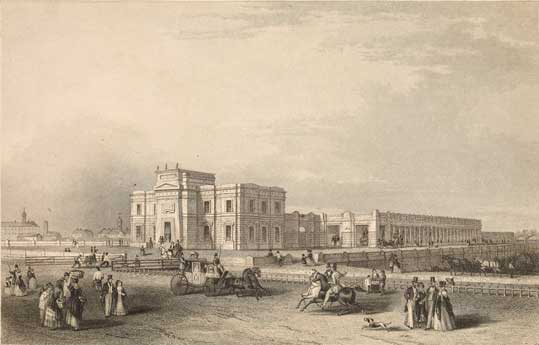Murder at the Broadstone terminus
Published in Features, Issue 5 (September/October 2022), Volume 30By Brian Griffin
Thursday 13 November 1856 appeared to be just a day like any other at the Midland Great Western Railway Company’s Broadstone terminus in Dublin. The company’s cashier, George Samuel Little, worked as usual on checking his accounts in his office. The sums of money with which he had to deal were greater than usual, due to the heavy train traffic to and from Mullingar fair earlier in the week. Little was considered a very quiet, inoffensive man who devoted himself to his employer’s interests and who was always regular in his accounts. On the morning of Friday 14 November Little’s sister went to the Broadstone terminus and informed Henry Beausire, the company secretary, that her brother had not returned the previous night to the home, which he shared with her and their mother. Beausire went to Little’s office and found that it was locked. A workman effected an entry through one of the windows.
Suicide or murder?
A dreadful sight met his eyes: Little was lying dead on his side in a pool of blood, his throat slashed through to the spinal column and there was also a deep cut on the left side of his mouth, which penetrated into his teeth. There was no sign of a struggle having taken place, as the office furniture was undisturbed and piles of money were stacked neatly where Little had placed them. There was no key in the locked door and none in the office, so the door was forced to allow entry to Beausire and the others waiting in the corridor. Despite the mystery of the missing key, and also the fact that there was no bloodied razor or any other bloodied weapon in the office, the witnesses at first thought that Little had committed suicide. Early newspaper accounts therefore reported that Little had killed himself, but these were quickly corrected when it was discovered that his head had received numerous blows from a hammer or similar object. According to Surgeon George Porter, Little was killed by one of these blows to the head, and his throat had been cut afterwards. This was, then, a case of murder, and robbery was the motive: although almost £1,600 in cheques and cash were found in the office, an examination of Little’s handwritten tallies revealed that between £300 and £400 was missing.
Dubliners were shocked by the savagery of the murder and for weeks afterwards speculation was rife concerning the murderer’s identity and how he had gained entry to Little’s office and left it after committing the crime. Superintendent Augustus Henry Guy of the Dublin Metropolitan Police’s G or detective division, assisted by Inspector Daniel Ryan, led the hunt for the killer. Progress was slow, despite the police interviewing all of the railway employees, and the DMP came in for considerable criticism for their apparent lack of success in solving the case. Press announcements of the arrest and quick release of several suspects in November and December only heightened the impression of police bungling. Some newspapers reported in December that the hard-pressed Dublin detectives were assisted for around a fortnight by the famous Scotland Yard detectives, Whicher and Smith, but that these left without achieving a breakthrough. There were even rumours that the police and prominent railway officials had resorted to the services of a clairvoyant in an effort to catch the culprit. By the end of December, the police had little to show for their efforts, apart from the discovery in the rafters of one of the terminus buildings of a canvas bag containing more than £43 in silver, which was believed to be part of the money stolen during the murder.
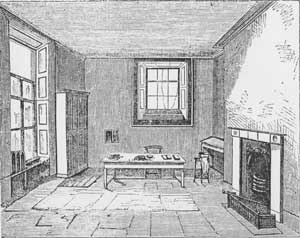
Above: The office where Samuel Little was murdered. James Spollen had done some work in it about a fortnight before, varnishing a table and putting Moroccan leather on furniture. (Illustrated Times, 11 July 1857)
Damning but inadmissible evidence
The seemingly moribund case was revived dramatically in June 1857 when a woman came forward to claim that her husband was the murderer. Mary Spollen, a native of Newtownmountkennedy, Co. Wicklow, told the police that on the night of the murder her husband, James, who was employed as a painter, glazier and general handyman at the Broadstone terminus, came to their residence with a bucketful of gold and silver, which he stated he had stolen from Little, and also that he had killed the cashier. It is possible that Spollen did not take the rest of the money as he had no easy means of carrying it away. According to his wife’s account, Spollen waited in the corridor until Little unlocked the office door to use the nearby water closet at around 7 o’clock, and in his absence hid in the office and waited for Little’s return, and murdered him after Little had locked the door and sat down at his desk. Spollen took the key and made his escape through an office window, making his way along the roof of the building. On his return home he covered the bloodstains on his clothing with paint. He hid most of the stolen money in a bucket, which he secured down the chimney of one of the terminus buildings. Spollen removed the hidden money from the chimney after a few days and secreted it in various locations around the terminus; the police were able to find this money with Mrs Spollen’s assistance. She also stated that Spollen had thrown Little’s key in the nearby Bradogue river, and this was subsequently found by a boy inmate of the North Union workhouse in mud spoils that had been thrown up during police searches of the river. It appears that Mrs Spollen eventually informed on her husband out of fear that he would kill her and their children. Some days before she went to the police she had fallen violently ill and suspected that she had been poisoned. Spollen threatened to kill anyone who went for a doctor to assist her, but one of their four children secretly brought a doctor to see her. Mrs Spollen told the doctor that when her husband got up one night she and her children had been scared that he was going to cut their throats.
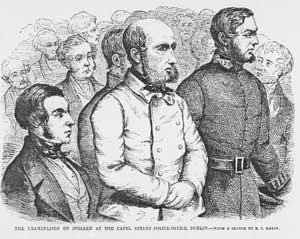
Above: James Spollen at the Capel Street Police Office. Spollen, who was born in Ferns, Co. Wexford, had lived in England ‘for a considerable time’ before moving to Dublin, where he had lived for the previous twenty-five years. He lost his right eye about twelve or thirteen years before 1857, due to inflammation brought on by cold. He was aged 41 at the time of the murder. (Illustrated Times, 11 July 1857)
Mrs Spollen’s damning testimony to the police was published in minute detail by dozens of Irish and British newspapers, and the press also provided detailed accounts of James Spollen’s arrest and statements to the DMP detectives, all of this almost certainly with the help of police insiders. Dublin was transfixed by the case: according to the Freeman’s Journal, ‘In every quarter of the city nothing is spoken of but the recent discoveries connected with the murder of Mr Little, and perhaps on no other occasion has there been caused such an amount of general excitement as the revelations of the “Broadstone tragedy” have created’. There was particularly intense interest in James Spollen, with newspapers describing his physical appearance and personal habits in minute detail. According to the Freeman’s Journal, Spollen’s forehead was ‘rather high, and indicative of considerable powers of thought’, and there ‘is nothing of the usual criminal type about his head, but the loss of his right eye imparts a slightly sinister aspect to a face which otherwise would be the reverse of repulsive. […] The back of the head is massive, and the general bearing of the man and the intelligent expression of his countenance indicate a class of mind superior to what might be expected from the position of life occupied by the prisoner’. Spollen appeared to be ‘a man of some taste’, according to the Journal. This impression was strengthened by the description of Spollen’s cottage, which was just a ‘stone’s throw’ from Little’s office: it was comfortable, neatly furnished, adorned with lots of pictures in gilt frames, and the small front garden was neatly laid out in flower beds, plots of peas, and a rockery. Spollen’s pet canary was kept in a handsome brass wire cage, which hung outside the front door, while he also kept a small rabbit in a neat wooden cage.
Could this apparently refined workman be a murderer? The police were convinced that he was, but, because his wife’s testimony against him was not legally admissible, they had to use other evidence to prove his guilt. Spollen’s trial, which took place in Green Street courthouse from 7-11 August 1857, ‘excited more public interest throughout the British Islands than any criminal prosecution of the present century’, according to a contemporary transcript, which was published in Dublin and sold for one shilling. The trial hinged partly around circumstantial evidence such as the hidden sums of money that were found at various locations at the Broadstone terminus, a razor with Spollen’s name on it that was found when the Royal Canal basin near the terminus was dredged and searched, and a hammer that was allegedly used to strike the blows that killed Little. John Adye Curran, one of Spollen’s defence counsels, cast doubt on whether any of this evidence proved Spollen’s guilt. He also skilfully attacked other seemingly damning evidence against Spollen, such as statements from two of his children, Lucy aged 10 and Joseph aged 13, that on the night of the murder they had seen their father on the roof of the forge opposite their cottage and that he had put something down the chimney. The prosecution argued that this was the bucket of stolen money. Curran countered that the children were lying, suggesting that they were coached by their mother to give this evidence and that they were colluding with her to have their father hanged for murder. Curran’s arguments seem to have been persuasive, as the jury, after deliberating for less than an hour-and-a-half, delivered a verdict of ‘not guilty’.
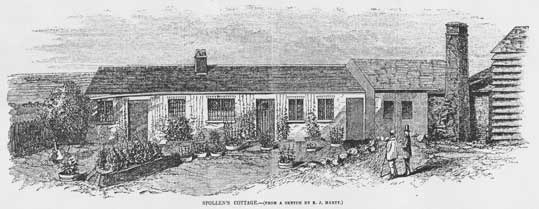
Above: The Spollen cottage, which was a ‘stone’s throw’ from Little’s office, which it directly faced. (Illustrated Times, 11 July 1857)
‘A New Song on the Liberation of Mr James Spollen’
The broadsheet ballad ‘A New Song on the Liberation of Mr James Spollen’ suggests that some Dubliners, at least, agreed with the jury’s verdict. The ballad’s lyrics mirror Curran’s suggestion that Mary Spollen made her children perjure themselves, to ensure their father’s execution in order to secure £350 in reward money. Only a minority of people appear to have believed in Spollen’s innocence, however. The hostility that Spollen faced when he booked Fishamble Street Theatre to give a series of talks about the Little murder case, to raise money so that he and his oldest son, James, could emigrate to New York is probably a better gauge of public opinion. (Mary refused to have anything further to do with her husband after his acquittal. It is possible that Spollen had a closer bond with his eldest son than with his other children as they both worked at the Broadstone terminus, where James junior was an apprentice fitter). On the first and only day on which the talks went ahead, few people paid the entrance fee, and those who did were convinced of Spollen’s guilt. One responded to Little’s request for subscriptions by saying that ‘he had paid a shilling to see how far the man’s audacity would carry him, and that he would willingly give another to buy a rope for him’. The paltry audience, many of whom were believed to be detectives, was dwarfed later that evening by a hostile crowd of almost 1,000 people outside; the theatre doors had to be closed to prevent them from forcing their way inside. Undaunted, it appears that Spollen planned to hold similar public talks in Cork, but this came to naught when he was arrested on 22 August 1857 and this time charged with the robbery that was committed during the murder. As the police offered no new evidence against him, however, on 27 October Dublin’s grand jury found ‘no bill’ in his case and Spollen was released from custody a few days later.
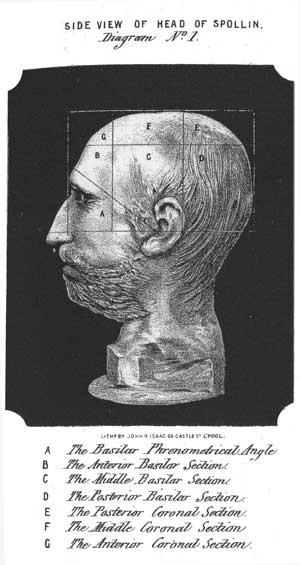
Above: One of Frederick Bridges’s casts of Spollen’s head, with phrenological measurements. Bridges wrote that Spollen’s head type was typical of ‘the most dangerous class of criminals’.
Emigration
Spollen and his eldest son then moved to Liverpool, again hoping to raise enough money to fund a new life in either Australia or America. He was assisted in this by a publican named Thomas, who ran a ‘liquor vault’ in Preston Street and who hoped to profit by charging audiences to hear Spollen speak about his case. Thomas paid for a scale model of the Broadstone terminus to be made, similar to that used by the prosecution in Spollen’s murder trial: Spollen used the model to prove his innocence to audiences of the few public talks he gave in Liverpool before the police intervened to put an end to this unauthorised exhibition. Spollen also allowed himself to be interviewed around thirty times by Frederick Bridges at the latter’s Phrenological Institution on Mount Pleasant, with each interview lasting about three hours. Bridges made some casts of Spollen’s head and published an account of Spollen’s ‘phreno-physiometrical characteristics’, which was derived from his ‘scientific’ measurements of Spollen’s skull. If Spollen had been hoping that Bridges would provide ‘scientific’ corroboration of his innocence, he was to be sadly disappointed. Bridges wrote that Spollen’s head type was typical of ‘the most dangerous class of criminals’, with his small ‘organs’ of ‘veneration, benevolence and conscientiousness’ overpowering his ‘organs’ of ‘secretiveness’, ‘combativeness’, ‘self-esteem’, ‘destructiveness’ and ‘acquisitiveness’. Bridges repeated his assessment of Spollen’s murderous propensities in a series of public talks in Dublin, in which he also publicised his pamphlet. He also revealed that Spollen left Liverpool in late January, presumably to emigrate to New York: before leaving, Spollen ‘had his whiskers shaved, hair dyed, and beard trimmed, and so completely was he disguised that his own son did not at first know him’. According to the Illustrated Berwick Journal Spollen arrived in New York in March 1858, but notwithstanding his attempts to change his appearance, he was recognised by the landlady of the first tavern he entered, who presented him with his portrait, which had a drawing of the murder scene affixed at the back. After this, Spollen appears to have successfully hidden his identity and started a new life in America.
Brian Griffin is adjunct associate professor in history at Maynooth University.
Further reading
Anon., Trial of James Spollen, for the Murder of George Samuel Little, at the Broadstone Terminus of the Midland Great Western Railway, Ireland, August 7th, 8th, 10th & 11th (Dublin, 1857).
F. Bridges, Phreno-Physiometrical Characteristics of James Spollin, Who Was Tried for the Murder of Mr George S. Little, at the Broadstone Terminus of the Midland Great Western Railway, Ireland, on the 13th of Nov., 1856, With an Account of the Author’s Interviews With Spollin, &c, &c (Liverpool, 1858).
A. Wade, Foul deeds and suspicious deaths in Dublin (Barnsley, 2008).










